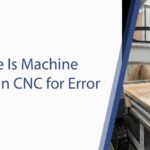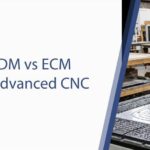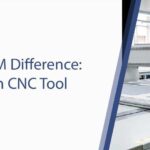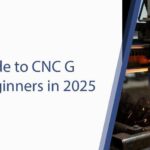If you’ve ever marveled at the precision and complexity of parts produced by CNC machines, you’re essentially witnessing the silent, intricate dance orchestrated by CNC G-codes.
Often referred to as “G-code programming,” this alphanumeric language is the fundamental instruction set that tells a CNC machine exactly what to do: where to move, how fast to move, what tools to use, and much more.
Understanding CNC G-codes is not just for programmers; it’s crucial for anyone looking to truly master their CNC machine, optimize their processes, and unlock unparalleled manufacturing capabilities.
This article will dive deep into the world of G-code, its structure, common commands, and how Radonix control systems flawlessly interpret this vital language.
Why Understanding CNC G-codes is Indispensable for Modern Manufacturing?
In the realm of Computer Numerical Control (CNC) machining, CNC G-codes are the bedrock. They are the universal language that bridges the gap between a human’s design intent and a machine’s physical execution.
Why is it so important to grasp this language?
- Precision and Control: G-codes allow for micro-level control over every aspect of the machining process, ensuring the highest possible precision in part dimensions and surface finish. This is vital for industries demanding tight tolerances, like aerospace, medical, and automotive.
- Optimization and Efficiency: While CAM software generates most G-code, a good understanding of CNC G-codes allows operators and programmers to manually optimize toolpaths, adjust cutting parameters, and troubleshoot issues on the fly. This leads to reduced cycle times, less material waste, and improved overall efficiency.
- Troubleshooting and Debugging: When something goes wrong, being able to read and interpret G-code is invaluable for identifying errors, diagnosing machine behavior, and making quick corrections, significantly reducing downtime.
- Customization and Flexibility: For unique or specialized operations, manual G-code programming or editing is often necessary. This provides unmatched flexibility to tackle complex geometries or specific machining strategies not easily generated by standard CAM software.
- Enhanced Machine Utilization: A deep understanding of CNC G-codes empowers users to push their machines to their limits safely and effectively, maximizing their return on investment.
- Bridging Software Gaps: Even with advanced CAM systems, subtle variations or specific machine requirements sometimes necessitate manual G-code adjustments to achieve desired results.
Simply put, mastering CNC G-codes is about gaining complete command over your CNC machine, transforming it from a mere tool into a highly responsive extension of your manufacturing expertise.
The Structure of a CNC G-code Program
A CNC G-code program is essentially a sequence of instructions, each on its own line, telling the machine what to do next. Each line, or “block,” typically contains one or more commands.
Here’s a breakdown of the typical structure:
- Block Number (N): While optional, block numbers (e.g., N10, N20) are used for program organization and easy navigation, especially during debugging.
- G-codes (Geometric Codes): These are the primary commands that define the type of motion or action. They usually start with the letter ‘G’ followed by a number (e.g., G00, G01, G02).
- M-codes (Miscellaneous Codes): These are auxiliary or “miscellaneous” commands that control machine functions other than motion. They start with ‘M’ followed by a number (e.g., M03, M08, M30).
- Axis Designators (X, Y, Z, A, B, C): These letters specify the target position for each machine axis. For example, X100 means move to 100 units on the X-axis.
- Feed Rate (F): Specifies the speed at which the cutting tool moves through the material (e.g., F200).
- Spindle Speed (S): Specifies the rotational speed of the spindle (e.g., S1500).
- Tool Number (T): Specifies which tool to select from the tool changer (e.g., T01).
- Comment ( ): Text enclosed in parentheses ( ) is ignored by the CNC controller and is used by programmers for notes and explanations, making the code more readable.
- End of Block (EOB): Implied by the end of the line, marking the end of a single instruction block.
Example of a simple G-code block:
N10 G00 X50 Y20 (Rapid traverse to X50 Y20)
- N10: Block number 10
- G00: Rapid traverse motion (move at maximum speed)
- X50 Y20: Target coordinates
- (Rapid traverse to X50 Y20): Comment for clarity
Essential CNC G-Codes: The Building Blocks of Machining
Let’s explore some of the most commonly used CNC G-codes and their functions. It’s important to note that while many G-codes are standardized across different CNC controllers, some specific implementations or advanced functions might vary slightly.
Radonix control systems are designed to be highly compatible with standard G-code syntax.
Motion Commands (G-codes defining movement)
- G00: Rapid Traverse (Non-Cutting Move)
- Function: Moves the tool at the machine’s maximum rapid feed rate. Used for non-cutting movements, such as positioning the tool to a starting point or moving between features.
- Syntax: G00 X… Y… Z…
- Example: G00 X100 Y50 Z10 (Move quickly to X=100, Y=50, Z=10)
- G01: Linear Interpolation (Straight Line Cut)
- Function: Moves the tool in a straight line at a specified feed rate. This is the most common cutting command.
- Syntax: G01 X… Y… Z… F…
- Example: G01 X100 Y50 Z-5 F200 (Move to X=100, Y=50, Z=-5 at a feed rate of 200 units/min)
- G02: Circular Interpolation – Clockwise (Arc Cut CW)
- Function: Moves the tool along a circular arc in a clockwise direction. Requires specifying the end point and either the arc center (I, J, K) or the radius (R).
- Syntax (using I, J): G02 X… Y… I… J… F… (I, J, K are incremental distances from the start point to the arc center for X, Y, Z axes respectively).
- Syntax (using R): G02 X… Y… R… F… (R is the radius of the arc).
- Example: G02 X50 Y0 I0 J-50 F150 (Start at X=0 Y50, move clockwise to X=50 Y0 with center at X=0 Y0).
- G03: Circular Interpolation – Counter-Clockwise (Arc Cut CCW)
- Function: Moves the tool along a circular arc in a counter-clockwise direction. Similar syntax to G02.
- Syntax (using I, J): G03 X… Y… I… J… F…
- Syntax (using R): G03 X… Y… R… F…
- Example: G03 X0 Y50 I-50 J0 F150 (Start at X=50 Y0, move counter-clockwise to X=0 Y50 with center at X=0 Y0).
Preparatory Commands (G-codes affecting subsequent actions)
- G17, G18, G19: Plane Selection
- Function: Defines the working plane for circular interpolation (G02/G03) and other commands.
- G17: XY Plane (most common for milling)
- G18: XZ Plane (common for lathe profiling)
- G19: YZ Plane
- Example: G17 (Selects the XY plane)
- G20 / G21: Units Selection
- Function: Specifies whether measurements are in inches or millimeters.
- G20: Inches
- G21: Millimeters (most common in metric regions, including those using Radonix controllers).
- Example: G21 (Sets units to millimeters)
- G40, G41, G42: Cutter Compensation
- Function: Allows the controller to automatically offset the tool path to compensate for the tool’s radius, ensuring the correct part dimension.
- G40: Cutter compensation off
- G41: Cutter compensation left (tool on the left side of the programmed path)
- G42: Cutter compensation right (tool on the right side of the programmed path)
- Example: G41 D01 (Turn on cutter compensation left using tool offset D01)
- G90 / G91: Absolute / Incremental Positioning
- Function: Defines whether coordinates are absolute (from the program origin) or incremental (relative to the current position).
- G90: Absolute positioning (most common)
- G91: Incremental positioning
- Example: G90 (All subsequent coordinates are absolute)
Other Important G-codes
- G28: Return to Home Position (Reference Point)
- Function: Commands the machine to return to its predefined home or reference position.
- Syntax: G28 X0 Y0 Z0 (Move all axes to their home positions)
- G92: Set Coordinate System Offset
- Function: Sets a temporary work coordinate system. Useful for quickly moving the program origin.
- Example: G92 X0 Y0 Z0 (Sets current tool position as the new program origin)
Essential CNC M-Codes: Machine Control Commands
M-codes handle various machine functions, acting as “miscellaneous” or auxiliary commands.
- M03 / M04 / M05: Spindle Control
- M03: Spindle On (Clockwise rotation)
- M04: Spindle On (Counter-Clockwise rotation)
- M05: Spindle Off
- Example: M03 S1000 (Turn spindle on clockwise at 1000 RPM)
- M08 / M09: Coolant Control
- M08: Coolant On
- M09: Coolant Off
- Example: M08 (Turn coolant on)
- M06: Tool Change
- Function: Initiates a tool change. Often preceded by Txx to select the tool.
- Example: M06 T02 (Change to tool number 2)
- M30: Program End and Reset
- Function: Signals the end of the program and typically resets the controller, ready for the next program.
- Example: M30
- M00 / M01: Program Stop
- M00: Program Stop (Unconditional stop; machine halts until manually resumed)
- M01: Optional Program Stop (Machine halts only if “Optional Stop” function is enabled by the operator)
- Example: M01
A Sample CNC G-code Program (Milling a Simple Square)
Let’s illustrate how CNC G-codes come together to perform a basic milling operation – cutting a 50×50 mm square from a sheet of material.
(Assumptions: Starting at Z=10mm above material, origin at bottom-left corner of the square, 10mm deep cut, 1000 RPM, 150 mm/min feed rate)
G-Code
N010 G21 (Set units to millimeters)
N020 G90 (Set to Absolute Positioning)
N030 G17 (Select XY plane)
N040 G00 X0 Y0 Z10 (Rapid to start point – X0 Y0, Z10mm above material)
N050 M06 T01 (Tool change to Tool 1)
N060 M03 S1000 (Spindle ON, clockwise, 1000 RPM)
N070 G04 P2.0 (Dwell for 2 seconds to allow spindle to reach speed)
N080 G01 Z-10 F50 (Plunge down to Z-10mm at 50 mm/min feed rate)
N090 G01 X50 F150 (Cut straight line along X-axis to X50)
N100 G01 Y50 (Cut straight line along Y-axis to Y50)
N110 G01 X0 (Cut straight line along X-axis to X0)
N120 G01 Y0 (Cut straight line along Y-axis to Y0)
N130 G00 Z10 (Rapid retract Z to 10mm above material)
N140 M05 (Spindle OFF)
N150 G00 X0 Y0 (Rapid to Home position in XY – or safe park position)
N160 M30 (Program End and Reset)
Understanding the Flow:
- Setup (N010-N040): The program starts by setting up the units (mm) and positioning mode (absolute). It then rapidly moves the tool to the starting XY coordinates (0,0) and a safe Z height (10mm above the material).
- Tooling and Spindle (N050-N070): It selects tool 1, turns the spindle on at 1000 RPM, and pauses for 2 seconds to ensure the spindle reaches full speed before cutting.
- Cutting (N080-N120):
- N080: Plunges the tool 10mm into the material.
- N090: Cuts horizontally along X-axis to X50.
- N100: Cuts vertically along Y-axis to Y50.
- N110: Cuts horizontally back to X0.
- N120: Cuts vertically back to Y0, completing the square.
- Retract and End (N130-N160): The tool retracts to a safe Z height, the spindle turns off, the machine rapids to its home position, and the program ends, resetting the controller for the next job.
How CNC G-codes are Generated and Used in Modern Workflows
While manual CNC G-codes programming is fundamental, most complex parts are programmed using CAD/CAM software. Here’s how it fits together:
- Design (CAD Software): Engineers and designers create a 2D drawing or 3D model of the desired part using CAD software (e.g., Fusion 360, SolidWorks, AutoCAD, SketchUp).
- Toolpath Generation (CAM Software): The CAD model is then imported into CAM (Computer-Aided Manufacturing) software (e.g., Mastercam, VCarve, Fusion 360’s CAM module). In the CAM software, the programmer defines:
- The raw material dimensions.
- The cutting tools to be used (geometry, material, number of flutes).
- Cutting strategies (e.g., roughing, finishing, pocketing, drilling).
- Cutting parameters (feed rates, spindle speeds, depth of cut).
- Nesting (for optimizing material usage).
- The CAM software then calculates the optimal toolpaths to remove material and forms a generic machine-independent output.
- Post-Processing: This is a crucial step. The generic toolpath data is fed through a “post-processor.” The post-processor is a small program specifically designed to translate the generic toolpath data into machine-specific CNC G-codes that your particular CNC controller (like a Radonix controller) can understand. Each CNC machine and controller combination often requires a unique post-processor.
- Execution (CNC Controller): The final G-code file is then loaded onto the CNC controller. The operator initiates the program, and the controller interprets each line of G-code, sending precise electrical signals to the machine’s motors, spindle, and other components to execute the desired motions and operations.
Radonix CNC control systems excel at this final stage, providing robust, reliable, and high-performance interpretation of G-code generated by a wide range of CAD/CAM software and post-processors. Our controllers are built to deliver the exact precision and speed commanded by your G-code programs.
Advanced Concepts and Best Practices for CNC G-codes
Beyond the basics, several advanced concepts and best practices can elevate your G-code programming and machine performance:
- Subroutines / Macros (G65 / M98 / M99): For repetitive tasks within a program (e.g., drilling multiple holes with the same pattern), subroutines allow you to write the common sequence once and call it multiple times, making the G-code more concise and easier to manage.
- Work Coordinate Systems (G54-G59): Instead of always referencing from the machine’s absolute origin, WCS (Work Coordinate Systems) allow you to define multiple origins for different setups or parts on the same table. This simplifies programming for complex fixtures or multiple workpiece setups.
- Tool Length Compensation (G43 / G49): Automatically adjusts the Z-axis position to compensate for different tool lengths, eliminating the need to manually re-zero the tool for each change.
- Canned Cycles (G81-G89): These are simplified G-codes that perform a sequence of operations (like drilling, tapping, or boring) with a single line of code, reducing programming time and complexity for common tasks.
- Variables and Conditional Statements (Fanuc-style Macro B): Some advanced controllers (often found in industrial settings) support variables, mathematical operations, and conditional logic within G-code, enabling highly flexible and automated programs.
- Error Handling and Alarms: Incorporating commands that check for specific conditions and trigger alarms or stop the program if an error occurs.
- Safe Programming Practices:
- Always start with a safe tool retraction (e.g., G00 Z_safe_height) before moving across the workpiece.
- Ensure proper spindle ON/OFF commands and coolant control.
- Use clear and concise comments to explain complex blocks or program sections.
- Always simulate the G-code program in CAM software or a dedicated G-code simulator before running it on the machine.
- Verify your machine’s reference points (home positions) are correctly set.
Radonix and the Flawless Execution of CNC G-codes
At Radonix, our commitment to precision and reliability is directly reflected in how our CNC control systems handle CNC G-codes.
Our controllers are designed from the ground up to:
- Accurately Interpret G-code: We ensure high compatibility with industry-standard G-code formats, minimizing conversion issues and maximizing the output quality from your CAM software.
- Execute Commands with Unrivaled Precision: Our advanced control algorithms translate G-code commands into precise motor movements, delivering the exact cuts and movements specified in your program.
- Handle High-Speed Machining (HSM): Radonix controllers are optimized to process large G-code files with many short line segments (common in HSM) smoothly and efficiently, preventing stuttering or loss of accuracy.
- Provide Real-time Feedback: Our control software provides clear, real-time displays of tool position, spindle speed, feed rate, and program progress, allowing operators to monitor G-code execution closely.
- Integrate Robust Safety Features: Even with perfect G-code, accidents can happen. Our systems incorporate comprehensive safety features that quickly respond to E-stops, limit switch triggers, and other critical events, ensuring operator and machine safety during G-code execution.
- Offer User-Friendly Interfaces: While G-code can be complex, our Radonix CNC control software presents it in an intuitive format, allowing for easy loading, starting, pausing, and even minor on-the-fly adjustments, making the entire G-code execution process as seamless as possible.
Whether you’re manually crafting G-code for a specific task or relying on advanced CAM software, Radonix controllers are engineered to be the dependable interpreters that bring your designs to life with utmost accuracy.
Conclusion
CNC G-codes are far more than just random characters; they are the highly structured language that commands the incredible precision and automation of CNC machines.
A solid understanding of these codes is a powerful asset, empowering you to optimize your manufacturing processes, troubleshoot efficiently, and push the boundaries of what your CNC machine can achieve.
At Radonix, we build the robust and intelligent CNC control systems that flawlessly interpret your CNC G-codes, translating your designs into tangible, high-quality products. We are committed to providing solutions that offer exceptional accuracy, speed, and reliability, ensuring that every line of G-code results in a perfect cut.
Explore our range of CNC control solutions and learn how Radonix can enhance your machining capabilities. Visit Radonix for more information and to connect with our expert team.
Contact Us:
- E-Mail: info@radonix.com
- Phone: +90 (553) 920 5500








